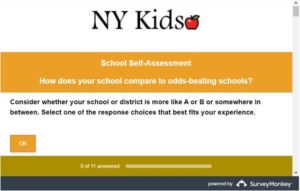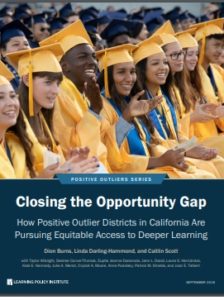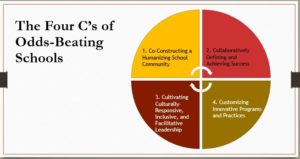New Report Shows that Odds-Beating Schools Focus on Equity and Prioritize Deeper Learning for Every Child
By Amanda Lester
A report released earlier this month by the Learning Policy Institute (LPI), Closing the Opportunity Gap: How Positive Outlier Districts in California Are Pursuing Equitable Access to Deeper Learning, reported on an investigation of seven “positive outlier” districts in California, providing a snapshot of why and how these districts were better able to support student success than similar districts. Findings described in this report are part of a larger mixed-methods project and included a report released earlier this year (as featured in this NYKids blog) which found that teachers’ qualifications are the most important school-related predictor of student achievement.
This report, and the broader study, are rooted in the idea that for students to find success in a constantly-changing society hallmarked by rapid innovation, each young person must be supported in developing critical thinking, problem-solving, collaboration, and communication competencies that together are defined as deeper learning skills. In the past, opportunities to develop these skills was not necessarily available to all students. However, in the effort to overcome persistent educational outcome disparities, and to ensure each and every young person is able to thrive beyond high school, access to deeper learning opportunities has emerged as a top priority.
Common Themes and Lessons Learned from California’s Positive Outliers
The seven positive outlier districts studied were selected from among more than a hundred California school districts in which students across racial, ethnic, and socioeconomic groups are outperforming similar students on new state assessments. These districts include: Chula Vista Elementary School District, Clovis Unified School District, Gridley Unified School District, Hawthorne School District, Long Beach Unified School District, San Diego Unified School District, and Sanger Unified School District.
Positive outliers (aka odds-beaters) are defined as schools that consistently demonstrate better than predicted outcomes for young people from different ethnic, racial, and socio-economic backgrounds. In many cases, the districts in the LPI study show evidence of closing the gap on a variety of student outcome measures, including graduation rates, and are providing more equitable opportunities overall.
LPI used a case study approach to investigate factors that enabled these districts to demonstrate better than predicted student outcomes such as human capital issues, resources, instruction and curriculum, professional learning, social and emotional learning, data and accountability, school culture, parents and community, schedules and organization.
The study of these factors offered these common themes and lessons that may help other districts and schools seeking to improve student outcomes:
- Prioritize learning for every child
- Build relationships and empower staff
- Value and support stability and continuity
- Attract, develop, and retain well-prepared teachers and leaders
- Build collective efficacy through shared instructional learning
- Take a developmental approach to instructional change
- Support collaborative, inquiry-based instruction and assessment focused on deepening understanding
- Use data and evidence strategically to inform teaching and learning; and
- Activate instructional supports for students based on their needs
Similar Themes and Lessons Found in NYS Odd-Beating Schools
While the LPI study was occurring on the west coast, NYKids was conducting its own Career and College Readiness (CCR) study of odds-beating high schools in New York State. Like in the LPI study, NYKids identified seven odds-beaters using similar criteria (student demographics and achievement – specifically graduation rates). Along with conclusions from the LPI report, findings from the NYKids’ CCR study offer insights into strategies, policies, and practices that enable these schools to achieve better than expected student outcomes when compared to similar districts.
In particular, the NYKids’ CCR study revealed promising innovations that yield odds-beating outcomes at each school, using lines of inquiry that aligned with the types of decisions identified in the LPI report as having influence over key decisions made about teaching and learning practice at the school level.
Four Commonalities Among NYS Odds-Beating Schools
The NYKids’ CCR study identified four important commonalities among the odds-beating schools that distinguish them from other schools and offer a partial blueprint for what can be done to facilitate the success of the greatest number of their students:
- Co-Constructing a Humanizing School Community
- Collaborating to Define and Achieve Success
- Cultivating Culturally Responsive, Inclusive, and Facilitative Leadership, and
- Customizing Innovative Policies, Programs and Practices.
Policy Changes in Support of Deeper Learning
The presence of the strategies and conditions for teaching and learning found in the LPI study positive outlier districts indicate that recent changes being made to California’s education policies and school funding structures intended to focus local school districts toward providing deeper learning opportunities for all students is being leveraged to positive ends. The degree to which districts were able to leverage these changes, and why they were or were not successful in doing so, illuminated the significant role districts play in enabling the success of school improvement efforts.
Stay tuned for our next blog exploring the role of districts in leveraging policy changes to support deeper learning for all children.
Opportunities to Learn More About Odds-Beaters in California and New York
To learn more about the LPI report featured in this blog, click here to access video and other resources resulting from the report’s launch event. Another LPI report, California’s Positive Outliers Districts Beating the Odds, describes the larger mixed-methods project and serves as the anchor for reports included in LPI’s Positive Outlier report series.
The NYKids website features a host of resources such as case studies and reports highlighting lessons learned from odds-beating schools in New York State, a new sample survey tool to see how your school compares to others, and COMPASS, a unique direct support opportunity that guides district & school teams to use continuous school improvement processes and tools. To learn more, visit: https://ny-kids.org/.




